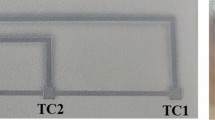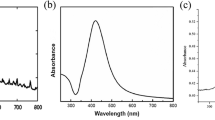Abstract
This paper presents a printed circuit board with a controlled current source for pulse electrochemical deposition of thin films. The developed current source consists of an analog-to-digital converter, a digital-to-analog converter, a buffer amplifier, a transistor, and is controlled by Arduino Mega board through the designed LabVIEW program. The measurement results of the designed current source are presented. The source provides an output current of up to 70 mA. The duration of time intervals is regulated with 1 ms increments and provides the required operating modes.
Access provided by Autonomous University of Puebla. Download conference paper PDF
Similar content being viewed by others
Keywords
1 Introduction
Today's economy is developing rapidly. Due to people's inadequate anticipation of the negative effects of highly developed industries and unfavorable prevention, there are three major global crises: energy shortage, environmental pollution, and ecological destruction. Energy is the material basis of human activities. The development of human society is inseparable from the emergence of high-quality energy and the use of advanced energy technologies. Therefore, the most urgent task is to vigorously develop green energy to alleviate these three crises. It is urgent to develop green energy [1].
In the past few decades, energy harvesting technology, which converts natural dissipating energy into usable energy, has been studied to help mitigate energy depletion around the globe, and thus various methods to harvest this energy have been suggested. In particular, solid-state conversion of heat to electricity is expected to be a key energy harvesting technology in the future. Thermoelectric energy harvesting can replace and does not require batteries in wireless networks for different applications [2]. Thermoelectric power generation technology is an energy harvesting technology developed based on the Seebeck effect of thermoelectric materials.
There are various ways of producing materials for thermoelectric generators. One of them is electrochemical deposition, which requires an external current source. The development of such cheap current source is the main goal of this work.
2 Production of Thermoelectric Materials
A thermoelectric generator (TEG) is a semiconductor device that converts the temperature difference into an electrical energy due to the [3,4,5]. Thermoelectric materials used to generate thermoelectric power are mainly semiconductor materials such as Bi2Te3, SiGe, and MnTe.
The thermoelectric power generation equipment made of these thermoelectric materials is small in size, light in weight, no vibration, no noise, long service life, and the advantage of long-term operation in extremely harsh environment is very suitable for a variety of uncontrolled sensors, satellite power supplies, beacons and navigation signs, as well as for areas of medical and physiological research [6]. TEGs are classified into two types: volumetric and thin-film devices. Thin-film TEGs are manufactured using solid-state semiconductor technologies compatible with the technology of manufacturing microelectromechanical systems (MEMS) [2].
In [5], we learned that due to its technical compatibility with silicon and high thermal stability, the application of semiconductor silicide may be one of the most important stages to improve the performance of thermoelectric generators. Therefore, the TEG of Uni-Leg structure is designed. The premise of the TEG structure is that the thermoelectric elements of two n-type and p-type thermoelectrically active semiconductor materials are interchangeable (TE), and they can be thermally connected in parallel and electrically connected in series (π structure), Or TE is made of only thermoelectrically active material semiconductor material-single thermocouple (Uni-Leg), as shown in Fig. 35.1. The Uni-Leg structure simplifies the structure of the thermoelectric generator; therefore, it reduces the cost of off-the-shelf products [7]. Therefore, it can be used in daily life.
3D geometry model of a Uni-Leg TEG [7]
Among thermoelectric materials, N-type bismuth telluride (Bi2Te3) and P-type antimony telluride (Sb2Te3) are attractive because of their high characteristics for thermoelectric generation applications near room temperature [8,9,10,11,12]. There are many methods for the synthesis of these materials. Pulsed electrochemical deposition is one of the widely used methods for producing thick films [13].
3 System hardware
This design uses Arduino Mega 2560 from Arduino to build the main controller. Arduino Mega 2560 is a micro control board based on ATmega2560. It has 54 digital input/output ports (15 of which can be used as PWM outputs), 16 analog input ports, and 4 UART interface, 16 MHz crystal oscillator, USB port, battery port, ICSP header and reset button [14]. Arduino Mega 2560 sends and receives data through MAX5533 and the serial port [15].
The block diagram of the developed current source is shown in Fig. 35.2 and consists of a digital-to-analog converter, an operational amplifier, a field-effect transistor, an analog-to-digital converter and several resistors. The transistor plays the role of a current source controlled through a voltage follower on the operational amplifier using a digital-to-analog converter, the output voltage of which is set by the Arduino board. The voltage across the resistors connected to the drain of the transistor, proportional to the generator output current, controlled by a high-precision analog-to-digital converter.
The resistance Rf is the feedback resistance, and Vin+ and Vin− are the operational amplifiers. In this design integrated circuits MAX5533, MCP3201 and MCP606 are used. The current source is controlled in the developed program in the LabVIEW environment through the Arduino Mega 2560 (Fig. 35.3).
4 System Software and Measurement Results
In [13], which describes the synthesis and study of thick films of electro-chemically deposited thermoelectric materials Bi2Te3 and Sb2Te3, some information is presented on the required parameters of the source for a pulsed electro-chemical deposition unit, among which the range of generated currents up to 35 mA and applied voltages up to 1.5 V. Synthesis of a thick film in this method is performed using an alternating current. The applied potentials used in pulsed deposition alternate between ON and OFF intervals. In the ON interval, potential Eon is applied to the sample and the flowing current is controlled for film growth, as in conventional electrochemical deposition. Meanwhile, the current is maintained at 0 mA during the OFF interval. In this case, it should be possible to set the pulse duration equal to 100 ms for the ON state and 200 ms for the OFF state.
The user interface of the designed LabVIEW program is shown in Fig. 35.4. Though this interface user can control time intervals and maximum output current of the source due to the internal 2-bit controlled reference of the digital-to-analog converter. Thus, the maximum current is 23.8 mA.
The designed controlled current source has been tested at room temperature (Fig. 35.5). Figure 35.6 shows the oscillogram of the developed current source output signal. X-axis scale: 100 ms/div, Y-axis scale: 5 mV/div.
Figure 35.6 was obtained in high resolution mode. In peak detect mode we can see some digital noise that will be eliminated during future work.
5 Conclusion
The paper presents designed adjustable current source for a pulsed electrochemical deposition unit with the following parameters:
-
the output current of the source is up to 24 mA when the DAC reference source is operating with a minimum voltage and up to 70 mA with a maximum voltage;
-
durations of time intervals are adjustable in 1 ms steps and provide the required operating mode.
References
D. Ahuja, M. Tatsutani, Sustainable energy for developing countries. SAPIENS Surv. Persp. Integrating Environ. Soc. 2(1) (2009)
A.S. Korotkov, V.V. Loboda, S.V. Dzyubanenko, E.M. Bakulin, Design of a thin-film thermoelectric generator for low-power applications. Russ. Microlectron. 48(5), 326–334 (2019)
R. Buslaev, A. Galitskaya, V. Loboda, Simulation of flexible thermoelectric generators based on Bi2Te3/Sb2Te3 synthesized by electrochemical deposition method, in 2019 IEEE International Conference on Electrical Engineering and Photonics (EExPolytech) (IEEE, Piscataway, NJ, 2019), pp. 54–57
A. Korotkov, V. Loboda, S. Dzyubanenko, E. Bakulin, Fabrication and testing of MEMS technology based thermoelectric generator, in 2018 7th Electronic System-Integration Technology Conference (ESTC) (IEEE, Piscataway, NJ, 2018), pp. 1–4
A.S. Korotkov, V.V. Loboda, Simulation and design of thin-film thermoelectric generators, in 2018 International Symposium on Fundamentals of Electrical Engineering (ISFEE) (IEEE, Piscataway, NJ, 2018), pp. 1–4
S.V. Volvenko, D. Ge, S.V. Zavjalov, A.S. Gruzdev, A.V. Rashich, E.L. Svechnikov, Experimental wireless ultra wideband sensor network for data collection, in 2017 Progress in Electromagnetics Research Symposium-Spring (PIERS) (IEEE, Piscataway, NJ, 2017), pp. 965–970
R. Buslaev, V. Loboda, Simulation of Uni-Leg thermoelectric generator, in 2018 IEEE International Conference on Electrical Engineering and Photonics (EExPolytech) (IEEE, Piscataway, NJ, 2017), pp. 27–31
L.M. Goncalves, P. Alpuim, G. Min, D.M. Rowe, C. Couto, J.H. Correia, Optimization of Bi2Te3 and Sb2Te3 thin films deposited by co-evaporation on polyimide for thermoelectric applications. Vacuum 82(12), 1499–1502 (2008)
K. Kaspar, U. Pelz, H. Hillebrecht, Polyol synthesis of nano-Bi2Te3. J. Electron. Mater. 43(4), 1200–1206 (2014)
C. Boulanger, Thermoelectric material electroplating: a historical review. J. Electron. Mater. 39(9), 1818–1827 (2010)
H. You, S.H. Baek, K.C. Kim, O.J. Kwon, J.S. Kim, C. Park, Growth and thermoelectric properties of Bi2Te3 films deposited by modified MOCVD. J. Cryst. Growth 346(1), 17–21 (2012)
D. Huo, J. Liang, H. Li, S. Xie, Y. Yu, Application of electro-chemical analysis technology in the research of metal electrodeposition. J. Casting Tech. 12, 153–161 (2016)
N.H. Trung, K. Sakamoto, N.V. Toan, T. Ono, Synthesis and evaluation of thick films of electrochemically deposited Bi2Te3 and Sb2Te3 thermoelectric materials. Materials 10(2), 154 (2017)
S.F. Barrett, Arduino microcontroller processing for everyone! Syn. Lect. Dig. Circ. Syst. 8(4), 1–513 (2013)
C.C. Zhih, S.K.V. Ragavan, M. Shanmugavel, Development of a simple, low-cost autopilot system for multi-rotor UAVs, in 2015 IEEE Recent Advances in Intelligent Computational Systems (RAICS) (IEEE, Piscataway, NJ, 2015), pp. 285–289
Author information
Authors and Affiliations
Corresponding author
Editor information
Editors and Affiliations
Rights and permissions
Copyright information
© 2022 The Author(s), under exclusive license to Springer Nature Switzerland AG
About this paper
Cite this paper
Cao, W. (2022). Adjustable Current Source for Pulse Electrochemical Deposition Installation. In: Velichko, E., Kapralova, V., Karaseov, P., Zavjalov, S., Angueira, P., Andreev, S. (eds) International Youth Conference on Electronics, Telecommunications and Information Technologies. Springer Proceedings in Physics, vol 268. Springer, Cham. https://doi.org/10.1007/978-3-030-81119-8_35
Download citation
DOI: https://doi.org/10.1007/978-3-030-81119-8_35
Published:
Publisher Name: Springer, Cham
Print ISBN: 978-3-030-81118-1
Online ISBN: 978-3-030-81119-8
eBook Packages: Physics and AstronomyPhysics and Astronomy (R0)










